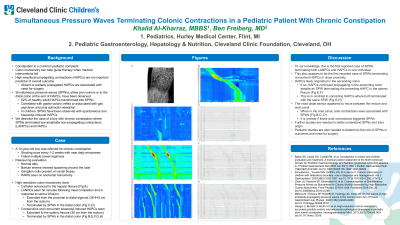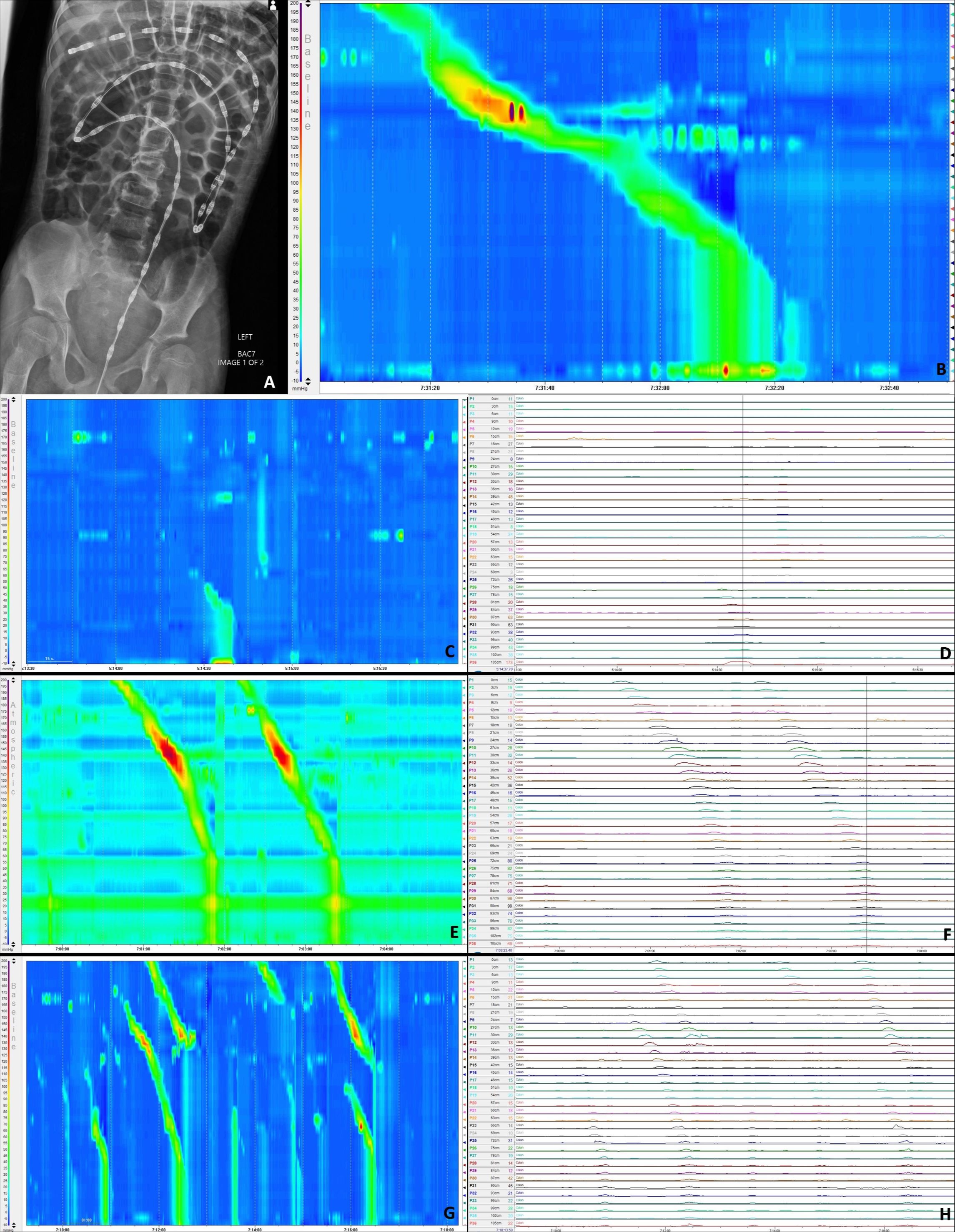Sunday Poster Session
Category: Pediatrics
P1192 - Simultaneous Pressure Waves Terminating Colonic Contractions in a Pediatric Patient with Chronic Constipation
Sunday, October 22, 2023
3:30 PM - 7:00 PM PT
Location: Exhibit Hall

Has Audio
- BF
Ben Freiberg, MD
Cleveland Clinic Foundation
Cleveland, OH
Presenting Author(s)
Khalid Al-Kharraz, MBBS1, Ben Freiberg, MD2
1Hurley Medical Center, Flint, MI; 2Cleveland Clinic Foundation, Cleveland, OH
Introduction: Constipation is a common pediatric complaint. When medical interventions fail, colon manometry can help guide therapy. High-amplitude propagating contractions (HAPCs) are an important predictor of overall outcome with absent or partially propagated HAPCS associated with need for surgery.
Simultaneous pressure waves (SPWs), pan-colonic and in the distal colon at the end of HAPCs, have been reported, correlating with gastro-colonic reflex and associated with gas expulsion and anal sphincter relaxation. 52% of healthy adult HAPCs transformed into SPWs. In children, SPWs have been observed with spontaneous and bisacodyl induced HAPCs.
We describe the case of a boy with chronic constipation where SPWs terminated low-amplitude non-propagating contractions (LANPCs) and HAPCs.
Case Description/Methods: A 10-year-old boy was referred for chronic constipation having failed multiple bowel regimens, stooling once every 1-2 weeks with near daily encopresis. Labs were normal. Barium enema showed spasming around the tube; ganglion cells were present on rectal biopsy and RAIRs were seen on anorectal manometry, ruling out Hirschsprung's disease.
High resolution colon manometry was done with the catheter advanced to the hepatic flexure (Fig A). LANPCs were seen 30 minutes following meal completion and in response to senna infusion, extending from the proximal to distal sigmoid (36 to 18 cm from the rectum), terminated by SPWs in the distal colon (Fig C,D). Bisacodyl induced HAPCs, consecutive and concurrent, extended to the splenic flexure (36 cm from the rectum), also terminated by SPWs in the distal colon (Fig B,E,F,G,H).
Discussion: To our knowledge, this is the first reported case of SPWs terminating both LANPCs and HAPCs in one individual. This also appears to be the first reported case of SPWs terminating concurrent HAPCs in close proximity. The HAPCs likely originated in the ascending colon. If so, HAPCs continued propagating in the ascending colon despite an SPW terminating the preceding HAPC in the splenic flexure (Fig E,F). This is in contrast to coinciding HAPCs in close proximity where both terminatied with the same SPW (Fig G,H).
The most distal sensor appeared to move between the rectum and anal canal. When in the anal canal, anal contractions were associated with SPWs (Fig B,C). It is unclear if these contractions triggered SPWs.
Further studies are needed to better understand SPWs and their origin. Pediatric studies are also needed to determine the role of SPWs in outcomes and need for surgery.

Disclosures:
Khalid Al-Kharraz, MBBS1, Ben Freiberg, MD2. P1192 - Simultaneous Pressure Waves Terminating Colonic Contractions in a Pediatric Patient with Chronic Constipation, ACG 2023 Annual Scientific Meeting Abstracts. Vancouver, BC, Canada: American College of Gastroenterology.
1Hurley Medical Center, Flint, MI; 2Cleveland Clinic Foundation, Cleveland, OH
Introduction: Constipation is a common pediatric complaint. When medical interventions fail, colon manometry can help guide therapy. High-amplitude propagating contractions (HAPCs) are an important predictor of overall outcome with absent or partially propagated HAPCS associated with need for surgery.
Simultaneous pressure waves (SPWs), pan-colonic and in the distal colon at the end of HAPCs, have been reported, correlating with gastro-colonic reflex and associated with gas expulsion and anal sphincter relaxation. 52% of healthy adult HAPCs transformed into SPWs. In children, SPWs have been observed with spontaneous and bisacodyl induced HAPCs.
We describe the case of a boy with chronic constipation where SPWs terminated low-amplitude non-propagating contractions (LANPCs) and HAPCs.
Case Description/Methods: A 10-year-old boy was referred for chronic constipation having failed multiple bowel regimens, stooling once every 1-2 weeks with near daily encopresis. Labs were normal. Barium enema showed spasming around the tube; ganglion cells were present on rectal biopsy and RAIRs were seen on anorectal manometry, ruling out Hirschsprung's disease.
High resolution colon manometry was done with the catheter advanced to the hepatic flexure (Fig A). LANPCs were seen 30 minutes following meal completion and in response to senna infusion, extending from the proximal to distal sigmoid (36 to 18 cm from the rectum), terminated by SPWs in the distal colon (Fig C,D). Bisacodyl induced HAPCs, consecutive and concurrent, extended to the splenic flexure (36 cm from the rectum), also terminated by SPWs in the distal colon (Fig B,E,F,G,H).
Discussion: To our knowledge, this is the first reported case of SPWs terminating both LANPCs and HAPCs in one individual. This also appears to be the first reported case of SPWs terminating concurrent HAPCs in close proximity. The HAPCs likely originated in the ascending colon. If so, HAPCs continued propagating in the ascending colon despite an SPW terminating the preceding HAPC in the splenic flexure (Fig E,F). This is in contrast to coinciding HAPCs in close proximity where both terminatied with the same SPW (Fig G,H).
The most distal sensor appeared to move between the rectum and anal canal. When in the anal canal, anal contractions were associated with SPWs (Fig B,C). It is unclear if these contractions triggered SPWs.
Further studies are needed to better understand SPWs and their origin. Pediatric studies are also needed to determine the role of SPWs in outcomes and need for surgery.

Figure: A: X-ray image of the high-resolution catheter with the tip at the hepatic flexure
B: SPW terminating HAPC; anal contraction seen associated with SPW
C and D: High resolution and wave form of low-amplitude non-propagating contraction in the splenic flexure terminated by SPW; anal contraction seen associated with SPW
E and F: High resolution and wave form of two consecutive HAPCs, each terminated by an SPW
G and H: High resolution and wave form of concurrent HAPCs terminated by the same SPW
SPW, simultaneous pressure wave; HAPC high-amplitude propagating contraction
B: SPW terminating HAPC; anal contraction seen associated with SPW
C and D: High resolution and wave form of low-amplitude non-propagating contraction in the splenic flexure terminated by SPW; anal contraction seen associated with SPW
E and F: High resolution and wave form of two consecutive HAPCs, each terminated by an SPW
G and H: High resolution and wave form of concurrent HAPCs terminated by the same SPW
SPW, simultaneous pressure wave; HAPC high-amplitude propagating contraction
Disclosures:
Khalid Al-Kharraz indicated no relevant financial relationships.
Ben Freiberg indicated no relevant financial relationships.
Khalid Al-Kharraz, MBBS1, Ben Freiberg, MD2. P1192 - Simultaneous Pressure Waves Terminating Colonic Contractions in a Pediatric Patient with Chronic Constipation, ACG 2023 Annual Scientific Meeting Abstracts. Vancouver, BC, Canada: American College of Gastroenterology.
